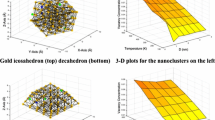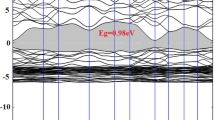Abstract
A simple model is used to predict nuclear quadrupole interactions caused by point defects at near-neighbor sites of probe atoms in cubic, metallic hosts. Also predicted are binding energies between the defects and impurity probe atoms. The model assumes that electrostatic interactions predominate over strain interactions. It is critically examined using data for111In/Cd probes next to solute atoms in noble metal hosts, obtained mostly by K. Królas, and next to vacancies in metals and intermetallic phases. The magnitude of quadrupole interactions is found to correlate well with charge transfer between host metal and defect. Charge transfer is taken to be proportional to the difference between work functions of the defect and host elements. Anansatz is proposed for the work function of a vacancy. Good correlations are obtained between experimental and calculated interactions for the generally oversized111In/Cd probe. The charge transfer model is believed to be applicable for other probes that are oversized.
Similar content being viewed by others
References
Schwarz, K., Blaha, P. and Madsen, G. K. H.,Comput. Phys. Comm. (2001).
de Boer, F. R.et al., Cohesion in Metals: Transition Metal Alloys, North-Holland, Amsterdam, 1988.
Bakker, H.,Enthalpies in Alloys: Miedema’s Semi-Empirical Model, Trans. Tech. Publications, Switzerland, 1998.
Sigalas, M., Papaconstantopoulos, D. A. and Bacalis, N. C.,Phys. Rev. B 45 (1992), 5777.
Schatz, G. and Weidinger, A.,Nuclear Condensed Matter Physics, Wiley, New York, 1996.
Recknagel, E., Schatz, G. and Wichert, Th., In J. Christiansen (ed.),Hyperfine Interactions of Radioactive Nuclei, Vol. 31,Topics in Current Physics, Springer, p. 133.
Pleiter, F. and Hohenemser, C.,Phys. Rev. B 25 (1982), 106.
Collins, G. S., Shropshire, S. L. and Fan, J.,Hyp. Interact. 62 (1990), 1.
Królas, K., Experimental studies of screening charge effects for impurities in Cu, Ag and Au, Report 1184/PL, Institute of Nuclear Physics, Krakow, 1982.
Królas, K.,Hyp. Interact. 60 (1989), 581.
Królas, K.,Phys. Lett. 85A (1981), 107.
Sternik, M., Królas, K. and Lindgren, B.,Hyp. Interact. 60 (1990), 873.
Baumvol, I. J. R.et al., Phys. Rev. B 22 (1980), 5115.
Butt, R., Haas, H. and Rinneberg, H.,Phys. Lett. 60A (1977), 323.
Zawislak, F. C.et al., Phys. Rev. Lett. 38 (1977), 427.
Sielemann, R., Metzner, H., Hunger, E. and Klaumuenzer, S.,Phys. Lett. 117A (1986), 87.
Sielemann, R., Metzner, H., Butt, R., Klaumuenzer, S., Haas, H. and Vogl, G.,Phys. Rev. B 25 (1982), 5555.
Weidinger, A., Wessner, R., Recknagel, E. and Wichert, Th.,Nucl. Inst. Meth. 182/183 (1981), 509.
van der Kolk, G. J., Post, K., van Veen, A., Pleiter, F. and de Hosson, J. Th. M.,Radiation Effects 84 (1985), 131.
Mueller, H. G. and Hahn, H.,Phil. Mag. A 50 (1984), 71.
Collins, G. S., Sinha, P. and Wei, M.,Hyp. Interact. C(1) (1996), 380.
Zacate, M. O. and Collins, G. S.,Defect and Diffusion Forum 194–199 (2001), 383.
Collins, G. S., Peng, L. S.-J. and Zacate, M. O.,Defect and Diffusion Forum 213–215 (2003), 107.
Collins, G. S., unpublished.
Collins, G. S. and Sinha, P.,Hyp. Interact. 130 (2000), 151.
Collins, G. S., Fan, J. and Bai B., In M. V. Nathalet al. (eds.),Structural Intermetallics, The Minerals, Metals & Materials Society, 1997, p. 43.
Fan, J., Ph.D. dissertation, Washington State University, 1992 (unpublished).
Zawislak, F. C.et al., Phys. Rev. Lett. 38 (1977), 427.
Cranshaw, T. E.,J. Phys. F 10 (1980), 323.
Cranshaw, T. E.,Journal de Physique, Colloque C2 40(Suppl. 3) 1979), C2-167-8.
Author information
Authors and Affiliations
Corresponding author
Additional information
On the occasion of the 80th birthday of Hendrik de Waard
Rights and permissions
About this article
Cite this article
Collins, G.S., Zacate, M.O. Charge transfer model for quadrupole interactions and binding energies of point defects with111In/Cd probes in cubic metals. Hyperfine Interact 151, 77–91 (2003). https://doi.org/10.1023/B:HYPE.0000020405.38846.1b
Issue Date:
DOI: https://doi.org/10.1023/B:HYPE.0000020405.38846.1b




